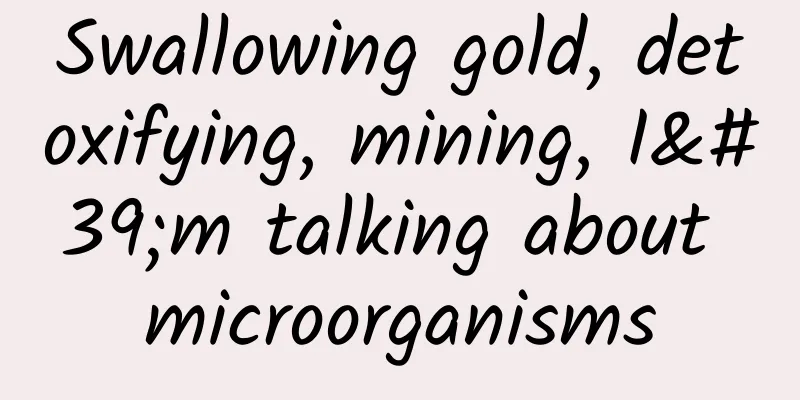Swallowing gold, detoxifying, mining, I'm talking about microorganisms

|
Produced by: Science Popularization China Produced by: Zhang Xiaodong (Guangdong Industry and Trade Vocational Technical College) Producer: Computer Network Information Center, Chinese Academy of Sciences Why did the "Dunhuang murals" fade? Why are space equipment afraid of microbial invasion? How do metal materials participate in the earth's cycle? What is the relationship between metals and microorganisms? Metal seems indestructible, but how can tiny microorganisms conquer it? Today, let us learn about the love-hate relationship between microorganisms and metals. Microbes that love to collect Metal elements are widely distributed in the natural environment and in human production. In the natural environment, metals generally exist in the form of metal minerals in the lithosphere, soil sphere, etc., and in the water environment such as oceans and lakes, they generally exist in the form of metal ions. Whether in the lithosphere or in seawater, microorganisms can complete the "collection" of metals and never get tired of it. Microbial "collection" of metals is also called metal fixation, bioconcentration or biosorption. There are many ways for microorganisms to "collect" metals, which can be summarized as extracellular adsorption and complexation, extracellular precipitation and intracellular accumulation. Extracellular precipitation refers to the process in which certain substances produced by bacteria react chemically with metals in the solution to form insoluble metal compounds. For example, phosphatase on the surface of some bacterial cells can cleave glycerol-2 phosphate, which then produces precipitation. Soluble metal monohydrogen phosphate ions can react with heavy metals such as tin, lead and uranium to form slightly soluble or insoluble precipitation in water, which then retains the metal ions. Surface adsorption refers to the process of metal cations being adsorbed by negatively charged functional groups on the surface of microorganisms. In heavy metal wastewater, metal ions are usually cations, which will constantly seek opportunities to combine with anions. It is precisely because of the presence of functional groups such as sulfur, phosphate, hydroxyl, and carboxyl on the surface of microbial cell walls that the surface of microorganisms has "negative charges". These functional groups can provide coordinated and complexed electron pairs for metal ions, allowing metals to be adsorbed on the cell wall, as shown in Figure 1. In addition, microorganisms can also "collect" metals through ion exchange, surface complexation, and other methods. Figure 1 Schematic diagram of microorganisms "collecting" metals Endocytosis refers to the process of fixing metals in microbial cells. Due to physical and chemical effects, metals are adsorbed to the cell surface, and then the "collected" metals are absorbed into the microorganism, as shown in Figure 2. For example, 8.5% of the chelated lead in Bacillus subtilis is physically encapsulated in the cell wall. Figure 2 Intracellular aggregation (Image source: Journal of Engineering Science) Microorganisms: Good Helpers of Humans In the 1980s, a new mineral exploration technology was reported, which used microorganisms to detect metal deposits. For a time, people were very enthusiastic about using microorganisms to "pan for gold", and microorganisms became a glorious "exploration worker". The reason why microorganisms can help humans complete exploration work is that different microorganisms have different sensitivities to the toxic effects of heavy metals. Some microorganisms can tolerate higher levels of metals, so these microorganisms will preferentially grow in areas with high metal content. Detecting this specific microorganism is equivalent to detecting metal deposits. Microorganisms are not only prospectors, but also veritable "miners" that can effectively mine the required metals. Microorganisms use their own redox properties on minerals to dissolve the metals in the minerals into the leaching solution (a solution that can convert solid ore into liquid, and then obtain metal-containing ore liquid to complete mining), or use the metabolites of microorganisms (such as citric acid, oxalic acid, Fe3+, etc.) to dissolve the minerals, or use the metal complexes in the minerals to oxidize and reduce the minerals to dissolve the minerals, and then achieve the purpose of mining. This is also one of the reasons why the "murals" lose their luster. In addition to detecting metals and mining minerals, microorganisms can also repair heavy metal pollution in the soil. Industrial development has brought about heavy metal pollution. Heavy metals discharged into the natural environment not only harm humans, but also threaten various microorganisms. However, microorganisms can "save themselves" by reducing the toxicity of heavy metal elements. Studies have found that some microorganisms in different soil environments change the valence of metal elements such as As, Cr, Hg and Zn through a series of activities, which changes their toxicity, solubility, mobility and other properties. For example, some acidophilic bacteria can convert highly toxic hexavalent chromium (a type of carcinogen) into less toxic and less soluble trivalent chromium through their own metabolic activities, significantly reducing toxicity. Microorganisms - a "big threat" to industry The "Shenyijing" says: "There is a beast in the south, with horns and feet the size of a buffalo, fur as black as lacquer, eating iron and drinking water, its feces can be used as weapons, its sharpness is like steel, and it is called the Iron-Eating Beast." This is a record of the iron-eating beast in my country. In nature, it is microorganisms and plants that bear the heavy responsibility of "eating iron." In addition to mutual attraction, some microorganisms and metals are also sworn enemies to some extent. Industrial equipment, aerospace equipment, ocean-going vessels, etc. have always been threatened by microorganisms. This is because the life activities of some microorganisms indirectly affect the electrochemical process of metal corrosion, which in turn aggravates the process of financial corrosion and thus destroys steel products. In essence, it is an electrochemical corrosion. Common microbial metal corrosion bacteria include aerobic iron bacteria, manganese bacteria and anaerobic sulfate-reducing bacteria. Among them, aerobic iron bacteria obtain energy from the oxidation of divalent iron, convert divalent iron ions into trivalent iron ions, and have the ability to produce iron hydroxide sediments, forming rust scale, which continuously aggravates the corrosion process and ultimately destroys steel products. The relationship between metals and microorganisms is complex and complicated, and many mechanisms of action are still to be improved. However, humans have never stopped using microorganisms in the field of metal materials, especially in heavy metal pollution treatment, soil remediation, mineral exploration, metal recycling and other aspects. |
<<: A woman had a high fever after "petting a cat". What does it have to do with parrots?
Recommend
Inventory: Do you still remember these 19 terrible mobile phones of this century?
Some of these phones you remember, and may have e...
A hornet's nest as big as a castle, do you dare to touch it?
“Poking a hornet’s nest” is a common childhood me...
4 case studies: The fission model of “group buying”
The method of group buying is to use social relat...
Nielsen Netcom joins Youpengpule's "500 million advertising red envelope" plan
Recently, after China's largest Internet TV s...
Just two days after the official release of WeChat 8.0.8, Apple iOS version 8.0.9 is here. What’s updated?
Recently, the news of the official release of WeC...
9 strategies for optimizing information flow ads!
Account optimization refers to the process of con...
After 17 years of companionship, Naruto carries too many bonds and youth for us!
Introduction: "Speaking frankly is my ninja ...
Apple, which has deep roots in China, will be hit hard by Trump's WeChat ban
Beijing time, August 10 morning news, because Ten...
Encyclopedia of Cat Family Medicine (Newly Revised Edition)
Introduction to the Encyclopedia of Cat Family Me...
Huawei sues Samsung for patent infringement; the mobile phone industry is already a "three-legged race"
On the 25th, Chinese technology giant Huawei sued...
Do mosquitoes like blood type O the most? These 5 types of people are their favorites!
Author: Meng Yao, Ph.D., Doctor of Medicine, Zhon...
As long as charging stations are popularized, will 300 kilometers of driving range of electric vehicles be enough? We find this is unrealistic!
The statement made by Xu Heyi, chairman of BAIC M...
Apple App Store makes a big move! Allowing developers and users to use third-party payment methods
This article is reprinted with permission from AI...
Evaluation of the effectiveness of Xiaohongshu advertising!
What do you think about whether Xiaohongshu adver...
BMW and other four major automakers jointly build fast charging stations: will cover the European continent
According to technology blog The Verge, four majo...









